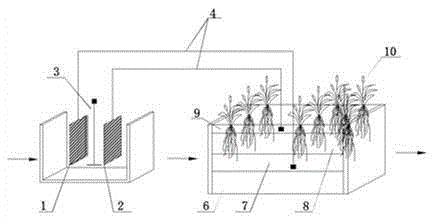Sewage treatment method for purifying refractory organic pollutants
A sewage treatment method and technology for organic pollutants, applied in the field of environmental engineering, can solve problems such as restricting development, and achieve the effects of reducing treatment costs, improving the biodegradability of materials, and enhancing power generation performance
- Summary
- Abstract
- Description
- Claims
- Application Information
AI Technical Summary
Problems solved by technology
Method used
Image
Examples
Embodiment Construction
[0014] The technical scheme of the present invention is described in detail below in conjunction with accompanying drawing:
[0015] Such as figure 1 The shown biofilm electrode reactor combined microbial fuel cell sewage treatment system for purifying refractory organic pollutants includes a biofilm reactor (BER) unit and a constructed wetland microbial fuel cell (CWMFC) unit. The sewage is firstly treated by the BER unit to degrade the refractory organic matter in the sewage, and the purpose of uniform water quality is achieved under the action of the agitator, and then flows into the CWMFC unit through the connecting water pipe between the systems, so that the organic matter in the sewage can be fully degraded, and at the same time The CWMFC unit generates electric energy; the electric energy generated by the CWMFC unit is transmitted to the BER unit through the wire connecting the BER unit and the CWMFC unit to supply power for the BER unit, so that the electric energy gen...
PUM
 Login to View More
Login to View More Abstract
Description
Claims
Application Information
 Login to View More
Login to View More - R&D
- Intellectual Property
- Life Sciences
- Materials
- Tech Scout
- Unparalleled Data Quality
- Higher Quality Content
- 60% Fewer Hallucinations
Browse by: Latest US Patents, China's latest patents, Technical Efficacy Thesaurus, Application Domain, Technology Topic, Popular Technical Reports.
© 2025 PatSnap. All rights reserved.Legal|Privacy policy|Modern Slavery Act Transparency Statement|Sitemap|About US| Contact US: help@patsnap.com

